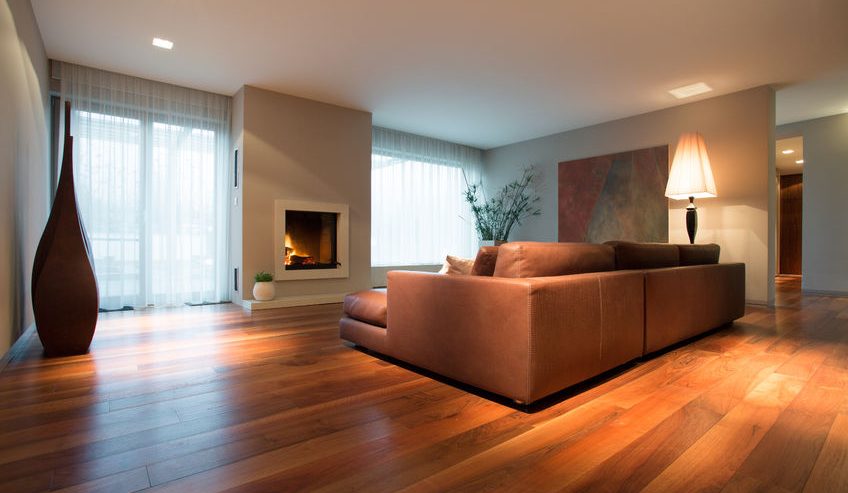The Six Considerations When Selecting Hardwood for Your Home
The addition of hardwood flooring to your home can add character, charm and timeless beauty. When you’ve made the decision to enhance your current flooring situation with hardwood, there are six considerations to take into account. Reading through this list will help you select the right hardwood flooring for your home. If you have any questions, or are ready to get started, you can contact a ServiceWhale flooring professional to guide you through it.
Your Floor’s Destiny
One of the most important questions when selecting hardwood floor is “Where is it going?”, regarding where you are laying the floor, specifically above or below grade (above or below ground level). This is important because, of the two major classifications of hardwood floors, only one is suited to below grade: Engineered. This question also comes into play based on the foot traffic you are expecting to subject the wood; more traffic needs a harder wood species.
Solid hardwood floors are just that: one solid piece of wood from top to bottom. Solid hardwood comes in varying thicknesses and can be installed almost anywhere in your home. Be careful, though, as solid hardwood is not well suited for basements—moisture and temperature swings can warp the wood. A benefit to using solid hardwood is that it can be refinished many times over, saving you the cost of replacing your floor.
Engineered hardwood floors are also somewhat self-explanatory, but also come with a misconception. Engineered hardwood floors are real wood. The term engineered comes in because they are manufactured using many layers of wood veneer, all bonded together. When the layers are stacked, each layer has the grain alternated, thereby making a very stable piece of hardwood. These crossed grains make engineered hardwood less prone to warping and expansion and contraction that solid hardwood can suffer from. This added stability means that engineered hardwood floors can be put anywhere in your home, including below grade (i.e.: basements).
Appearance is Everything, Appearances Are Everything
When it comes to judging books and people, it’s what is on the inside that counts. When selecting hardwood floor for your home, you DO get to decide based on looks. Both solid and engineered hardwood flooring choices come made from a variety of wood species, over 50 different styles. It is up to your taste and decorating style, as well as budget, what you choose.
You can choose from lighter tones, such as maple or ash wood. Lighter tones will show less dirt, dust or pet hair and make rooms feel open and airy. If darker tones are your preference, look for walnut or mahogany. These styles tend to lend a more formal, stately feel to your room. There are also numerous choices in between.
To Shine or Not to Shine?
Another preference choice when selecting your hardwood floors is the level of shine or sheen on the flooring. Flooring finishes come with different sheens, much like paint. There are glossy, semi glossy and matte finishes. As a general rule of thumb, the lower the sheen—whether flooring or paint—the less visible imperfections will be.
While this is strictly a preference choice, you may be limited in your options, based on if you have a factory finished instead of site finished floor. If factory finished, you may be limited by the finishes the factory chooses for your flooring choice.
Nice Floors Finish Last
The finishing of your hardwood is the final sanding and leveling of your wood and the application of the final sealant to protect and seal the wood. This can either be performed in the factory or in your home. There are pros and cons to each of these options.
On-Site finishing allows for greater flexibility in choice of finish, especially sheen. It also affords for a much easier repair process if there is any damage to the floor in the installation process. A major drawback to on site finishing is the length of the process and the mess. A lot of dust and debris will be generated from the sanding and you have to leave sufficient time for the finish to dry.
Factory finishing is exactly that. The sanding and sealant is applied in the factory and the finished wood is sent to your home. This method reduces the dust and hassle of on-site finishing, but you will be limited in the customization options. There is no wait with factory finished floors; you can walk on it as soon as it is installed.
Ahhh…That New Car Smell Floor Look
Once your floor is installed, the job is mostly done. To keep your floor looking showroom new, the biggest thing you can do is keep it clean. Hardwood floors should be cleaned regularly. You must be careful using water, so sweeping, dust mopping, or vacuuming is all you need to do for most of your day-to-day cleaning. If, however, your floor starts looking dull, you can use specialty hardwood floor cleaners, but you must choose one specifically designed for your type of floor to not damage it.
Other factors affecting your installed floors appearance are fading and scratches. As time passes, the sun and elements can dull or fade the floor. Oil based finishes will gradually turn a warm amber color, affecting the color of your floor, whereas water based finishes remain clear.
Shoes, moving furniture and pet nails call all cause scratches in the flooring. Usually these are minor, and go relatively unnoticed, but sometimes can be severe. Using throw rugs with protective backings and furniture pads and keeping pet nails trimmed are your best bets to prevent damage. In worst case scenarios, hardwood floors can be refinished, but this is usually best left to the professionals.
DIY Doable? Or A Disaster?
Now that you’ve answered the questions and decided hardwood flooring is for you, the question begs to be asked: “Can I DIY it?” That’s a tricky question. Some people can, but it is important to note that this is a significantly bigger task than painting your walls or even hanging kitchen cabinets. And correcting mistakes will cost a lot more than another gallon of paint. Hardwood floors are an investment in your home—don’t spend all that money just to be unhappy or frustrated with the result.
Using a ServiceWhale Professional will save you both time and money. They will walk you through all the steps: amount of flooring to purchase (more than you think—you should order at least 10% more than your floor size) and helping you chose finishes and species. They will also ensure it is installed properly. They will deal with testing and waterproofing the subflooring and laying out the flooring (including expansion gaps) and know how to work around the room’s architecture.
At the end of the day, laying a hardwood floor is a big investment in your home. Let the experience and expertise of a ServiceWhale flooring expert give you peace of mind, knowing the job is done right. Contact ServiceWhale to set up a flooring consultation today.





Comments
Comments are disabled for this post